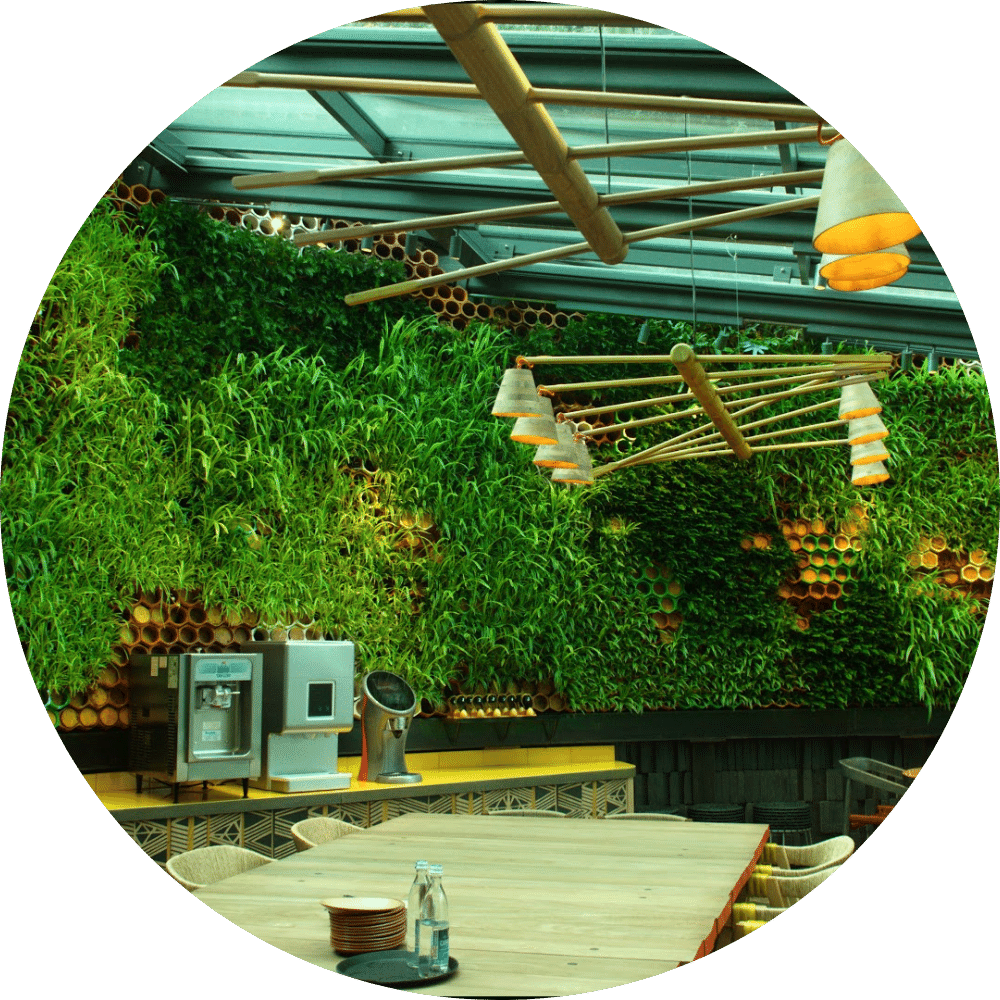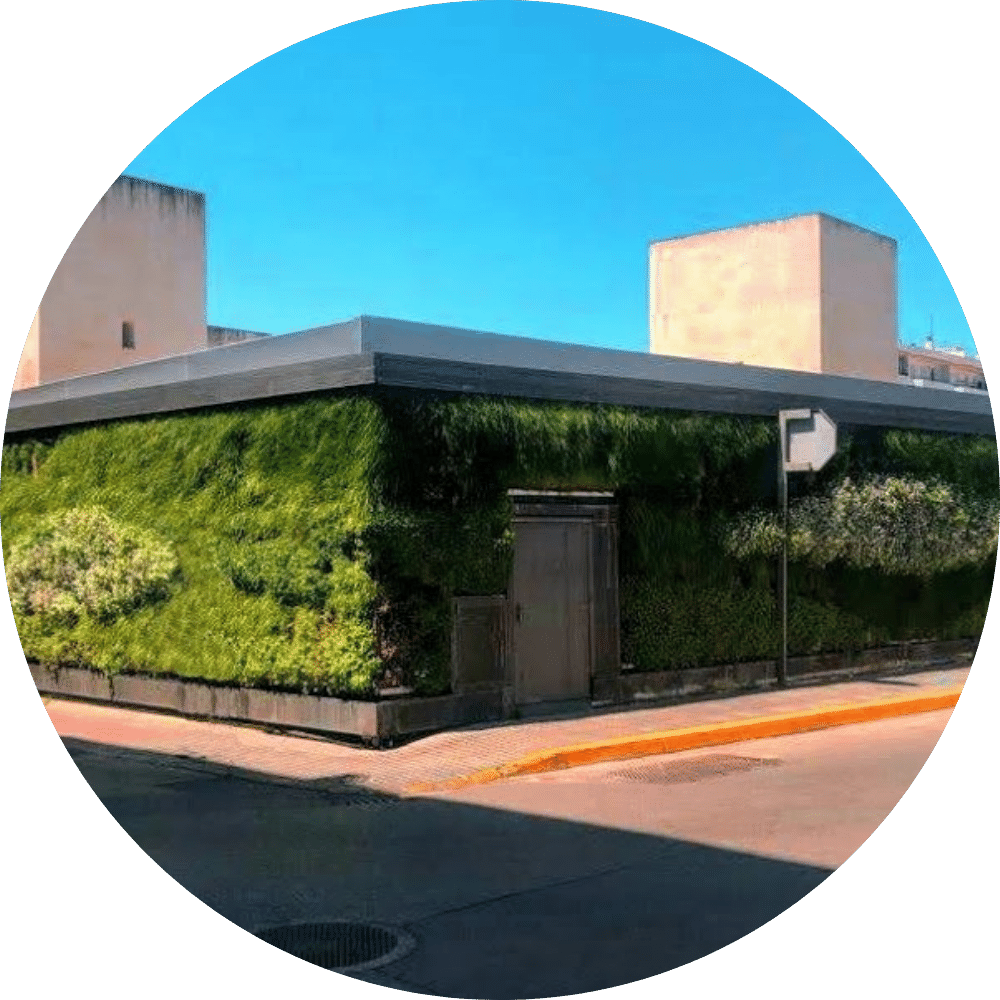Living walls
Design and integrate a green wall
If you are a designer or architect looking for technical features
Living walls, on this vertical gardens guide page you will discover:
Living walls: types, benefits and everything you need to know to make the right choice
Today, you can easily find over 20 different systems on the market to make a green wall. Each type aims to better adapt to a specific situation, but would you know which one to choose for your home?
What is a vertical garden or green wall?
A vertical garden is a system that allows vegetation to be planted vertically and that they develop properly, in outdoors and indoors..
Below you can see some examples of the great possibilities that these green walls offer us and the great diversity of aesthetic results.
At SingularGreen you will always find the vertical gardening system you need because we have a different solution for each situation. Even so, our bet focuses on three solutions that offer very great results.
Three vertical garden systems from SingularGreen
With these three specific vertical gardening systems, 98% of green walls can be solved.
Lorem ipsum dolor sit amet, consectetur adipiscing elit. Ut elit tellus, luctus nec ullamcorper mattis, pulvinar dapibus leo.
How many types of vertical gardens exist
1
VERTICAL GARDENS OF ORGANIC SUBSTRATE
These gardens use an organic substrate as the plant growth medium.
Normally they do not need an excessive contribution of fertilizer, but in return, they have less durability. The organic substrate will degrade and will have to be replaced.
Substrate gardens are going to be your best option if you are looking for a small garden at home that you want to maintain personally.
2
VERTICAL GARDENS OF HYDROPONIC SUBSTRATE
These gardens use an inert substrate as the plant growth medium.
This substrate require continuous fertilizer, as it is inert and does not fix the fertilizer, in return it is chemically stable and has a much longer durability.
This type will be better for large gardens that are controlled remotely.
Which vertical garden to choose in each case?
Given this basic classification, we are going to see the advantages and disadvantages of each type of vertical garden. Before starting this classification it is important to clarify that it is not a closed classification.
Recommending a type of vertical garden with specific characteristics and materials for a specific case does not imply that the rest of the systems cannot work for the same situation.
In fact, our systems have been tested in different situations with fantastic results. However, experience has taught us the pros and cons of each of them and that is what we are trying to convey in this classification.
INDOOR VERTICAL GARDENS
Indoor vertical garden or a small growing wall at home
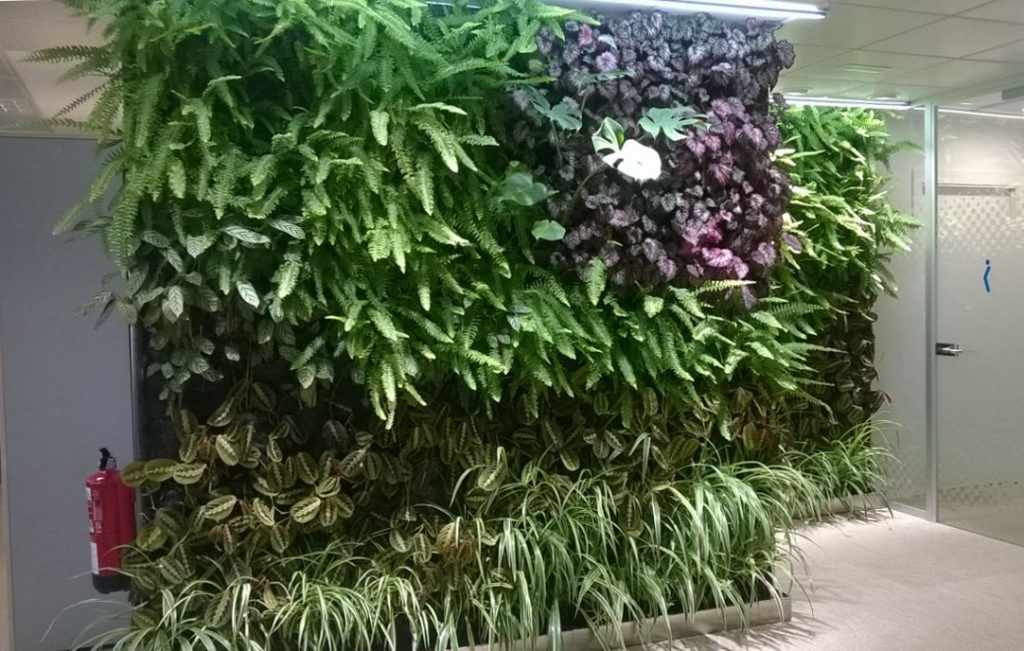
If you want to make a natural vertical garden at home, it is best to do it with a Sphagnum moss substrate (on which the planting will take place).
Sphagnum moss is antibacterial, ideal against rot, diseases and pests.
It retains up to 20 times its weight in water, a condition that makes it an excellent moisture manager and distributor.
It has a light texture that allows the oxygenation of the roots of the plants.
Also, it works great for indoor plants.
What about artificial vertical gardens?
OF PRESERVED PLANT BEST
If you don’t have a green thumb and don’t see yourself maintaining a natural indoor vertical garden, before you opt for an artificial vertical garden (which you can find in large stores like Ikea, Leroy Merlin or Amazon), we encourage you to take a look at the option of preserved or conserved plants.
Preserved plants don’t require water, light or soil, but they have a natural appearance (they are treated plants) and are healthier (with some of that essence of living vegetation) than artificial plants.
Take a look at some of our vertical gardening projects with preserved plants
A medium or large vertical garden indoors
If what you are looking for is a vertical garden for interiors that is somewhat larger than the previous one, our recommendation is to go for a specific textile or rock wool system (although the textile is usually more known and placed, we prefer the latter).
What we look for with this is to make a hydroponic system.
Why is a hydroponic system better than an organic substrate system?
It guarantees greater durability and less maintenance, in addition, both the textile systems and those of specific rock wool work very well indoors.
If you want to know more details about the best way to make your vertical garden at home with textiles, take a look at the following article, where we detail the materials and species to use.
If you want a textile vertical garden, we have the F+P cold system.
We leave you some examples of vertical gardens made with our textile systems (F+P and mixed F+P).
Evolution of a vertical garden of hydroponic substrate through pre-assembled systems
To make the installation of a vertical garden with hydroponic substrate easier, semi-assembled systems are usually offered, in order to facilitate assembly.
The operation of these green walls is the same as explained above and they can continue to be used indoors and outdoors with full guarantee and great durability.
With that idea, for example, two of our systems were born: F+P mixed and F+P.
Our systems consist of a metal bearing structure on which a cladding of plastic panels is arranged.On these panels the combination of felts or specific substrate will be fixed where the roots grow and a hydroponic irrigation solution circulates.
The total weight of the saturated and planted system is around 45 kg/m2 and the main advantage of this system is its easy maintenance.Other advantages of these systems is that the plant species are planted and replaced more easily, without the need to affect the rest of the garden, and the irrigation installations have a very fast installation and replacement.
OUTDOOR VERTICAL GARDENS
Although we have worked for years with textile substrate for outdoor vertical gardens, nowadays we do not recommend using it for different reasons:
In the textile substrate there are many outdoor plants that do not adapt correctly.
Another problem with this substrate is that if the irrigation fails, we need to have a very fast reaction capacity, since the substrate does not retain as much water as the specific rock wool.
For all this, to make large gardens outside, we always recommend using specific rock wool systems.
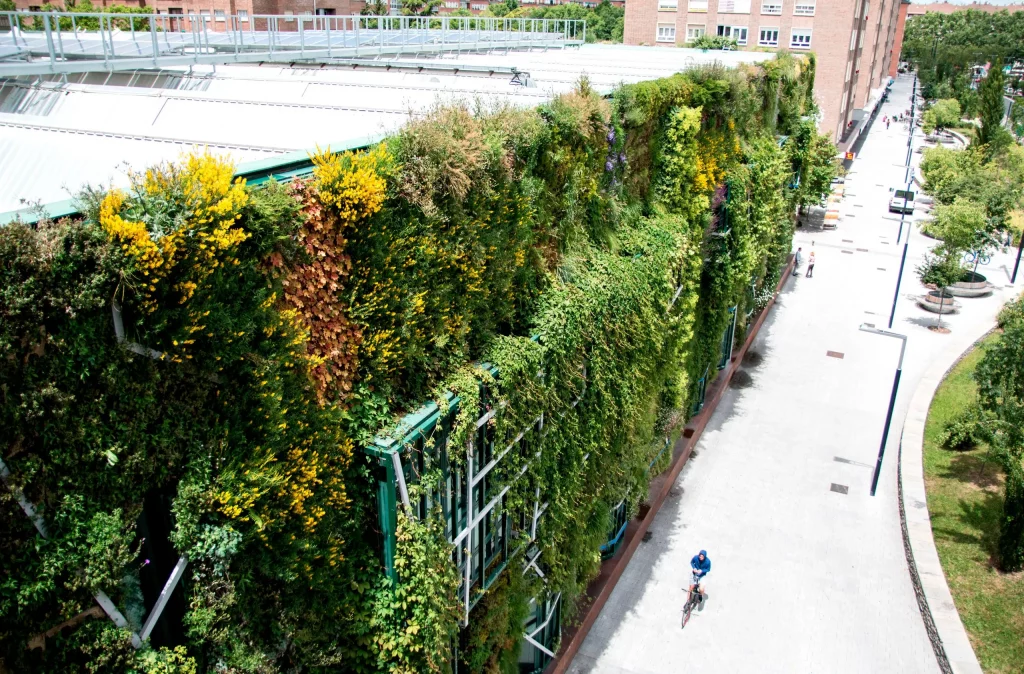
How to make a vertical garden outdoors?
En SingularGreen siempre encontrarás el sistema de jardinería vertical de exterior que necesitas porque tenemos una solución diferente para cada situación. Aún así nuestra apuesta se centra en tres soluciones que ofrecen grandes resultados.
A versatile and quick-to-install system
F+P SYSTEM that is again characterized by its easy installation and speed.
The total weight of the saturated and planted system is around 55kg/m2.
It shares most of the characteristics with the previous system with the only difference being that the substrate is made up of rock wool panels.
This material is able to withstand moisture for longer and also allows you to place any variety of plants.
AN OUTDOOR VERTICAL GARDEN AT AN ADJUSTED COST
If you have a large outdoor garden in mind and you are looking for a lower price, greater lightness and ease of execution, our proposal is a seeded vertical garden.
Our patented LeafSkin® system is a vertical hydroponic garden made up of a waterproof layer, sealant, distribution membrane and a substrate projected with a mixture of seeds.
Its greatest advantage is that it allows a certain prefabrication and can be sent to any place pre-assembled and seeded so that the end user only has to anchor it to the support and connect the irrigation pipes.
The only downside is that it will take longer for the plants to cover the entire surface.
The total weight of the saturated and planted system does not exceed 30 kg/m2.
ARE YOU LOOKING FOR A SPECIAL AESTHETIC IN YOUR LIVING WALL
No one disputes that the aesthetics of a vertical garden is already impressive and very eye-catching.
But what would you think of using a ceramic bottle rack factory, finished in terracotta, or lacquered in the color of your choice?
That is our most daring proposal with the Eco Bin system
The ceramic elements are installed with a slight inclination towards the interior to favor the storage of the irrigation water that runs through a subsequent substrate.
One of the most significant benefits of this system is acoustic absorption and the possibility of successful use of succulent plants. In addition to providing a unique and different aesthetic.
The total weight of the saturated and planted system is around 200 kg/m2.

What do you need to make a vertical garden?
Depending on the project, different components will be required.
IN CASE OF AN INTERIOR GARDEN WE NEED:
- Water intake for irrigation.
- Drain.
- A small cabinet where to place the irrigation system (filter, solenoid valves, inducers).
- Specific lighting so that the plant can live and develop correctly.
The accumulation or excess of salts can prevent the plants from developing well. That is why even in closed circuits there comes a time when it is necessary to change the water in the tank.
IMPORTANT: The drain is completely necessary because we need an outlet for excess water.
IN CASE OF AN OUTDOOR GARDEN WE NEED:
In addition to the previous points, we will need to take into account the weather and the orientation.
The selection of species will never be the same in different climates, but it will also affect the direct sunlight that the plants will receive.
COMPONENTS OF A VERTICAL GARDEN
Every vertical garden is basically made up of four components:
-
The support structure. It is what gives us stability to support our panels and plants.
-
Waterproof layer that guarantees that the humidity that we have in the substrate does not pass to the wall in any case. It must always be fully guaranteed that the wall is protected and that neither roots nor moisture can penetrate it.
-
The substrate. As we have already seen, the substrate can be an inert substrate or an organic substrate.
-
The plants. Conveniently selected according to each situation and/or tastes.
These four layers are essential and can be structured or materialized differently, depending on different factors.
IMPORTANT: Have in mind that depending on the system and the materials you choose, you will be able to have a smaller (between 8 different species), medium (between 40 or 50 different species) or wide range of plants, being able to work with 100 different species. in the same garden.
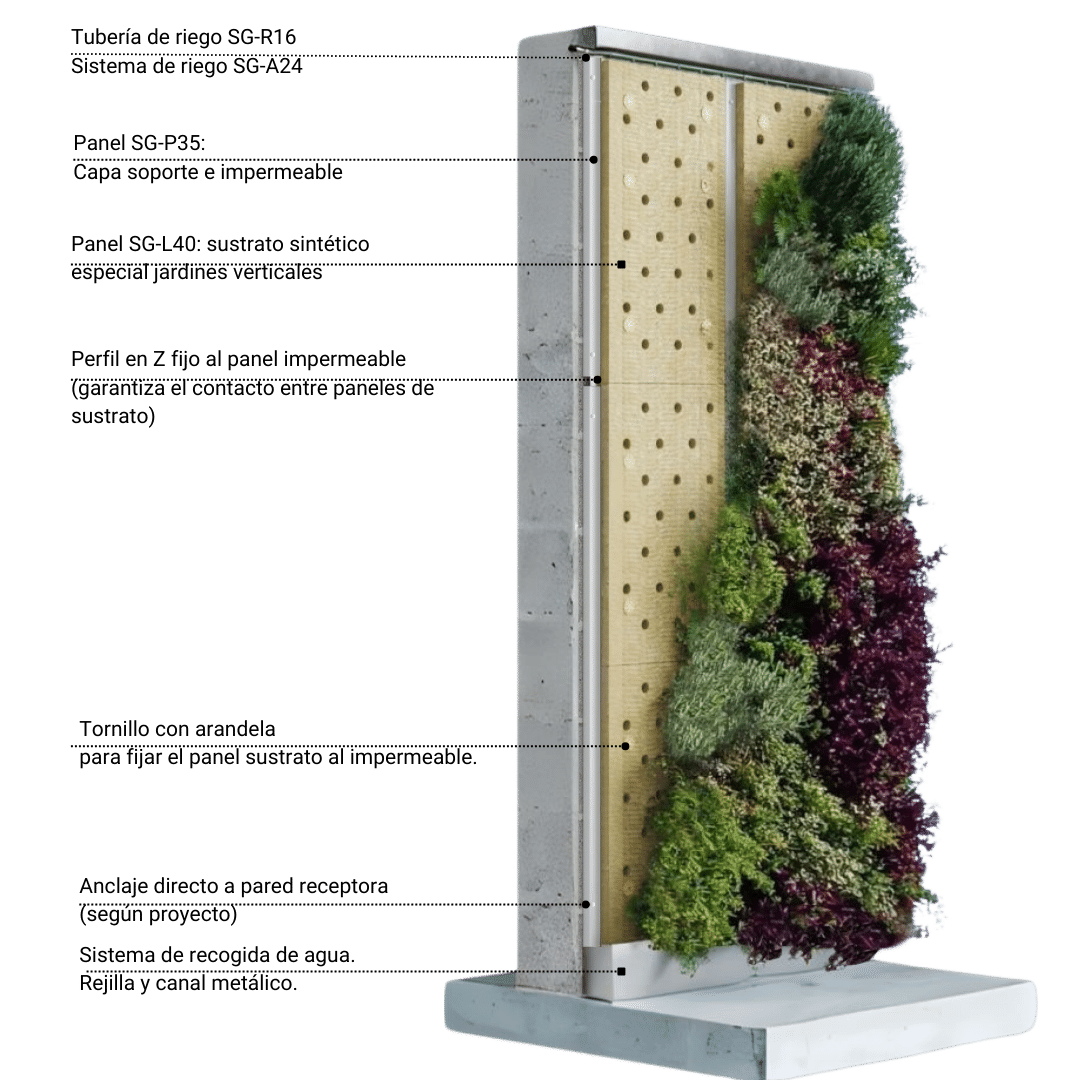
Maintenance of a vertical garden
At SingularGreen we distinguish between two types of maintenance:
VISUAL MAINTENANCE
If it is a personal vertical garden (that one that you do as a hobby and you have in your house) the maintenance would be like any plant or any pot that you have in your house.
You have to be aware that it does not have pests, to water, if you want to change a plant or if a plant does not work well.
They are small gardens and yes, you have to like gardening.
You have to like touching plants, changing them.
This work is part of the joy of having a vertical garden.
MONITORED MAINTENANCE THROUGH REMOTE CONTROL
From a certain size, we always recommend doing remotely monitored maintenance.
Why?
If we are going to make a small vertical pallet garden, maintenance is simple; add a little substrate, change a plant, control pests, watering…etc.
If we scale this same pallet garden to, for example, 50 square meters of pallets, all those little problems that we have are multiplied by 50 and we need another type of strategy.
A monitored garden will send an alert in case of:
- Water shortage
- Excessive flow (leaks, breakages, etc.)
- Low flow (blockages, clogging, etc.)
- Power outage
It is important tp have a rapid reaction capacity to attend to this alert, since if they are not attended to, that vertical garden will be doomed.
Although it seems exaggerated, failures happen sooner or later, whether for human reasons (a switch that someone turns off) or mechanical reasons (a solenoid valve that gets clogged)
That is why it is very important that there is not only an alert system but that there is someone to attend to them.
The basics of vertical garden maintenance regardless of the system we use is the ability to attend it.
Benefits of vertical gardens
Although below there is a series of studied and verified benefits, at this point we want to insist on how one feels when being next to a natural vegetal wall.
Despite it’s hard to put into words, it’s clear that the feeling has less to do with the dust it absorbs or how it regulates temperature. Nor with aesthetics, but with sensations and comfort. Even so, the verified benefits are the following:
DIRECT SAVINGS BENEFITS
They save space: The plant walls are hung vertically, taking advantage of a previously existing space.
Time: It is not necessary to remove weeds.
Money: They reduce the interior temperature of a building by up to 5ºC in summer as well as maintaining it in winter, saving up to €500/m2 per year. (Akira Hoyano, professor at the Tokyo Institute of Technology)
They save water: Water consumption is balanced and optimized due to the possibility of installing a closed irrigation circuit.
They save maintenance :They do not attract or allow the proliferation of insects and bacteria since this system provides a biological repellent.
HEALTH BENEFITS
1 m2 of plant cover generates the oxygen required by one person throughout the year. (Darlington, 2001)
1 m2 of plant cover traps 130 grams of dust per year. (Darlington, 2001)
A 4-storey building (60 m2) with a green facade can filter 40 tons of harmful gases per year. (Wolverton et al. 1989)
In addition, it is capable of trapping and processing 15 kg of heavy metals. (Darlington, 2001)
Improves performance and reduces discomfort for people who have vegetation in their workplace. (Lohr et al. 1996; Bringslimark, et al. 2007)
The vegetable insulation reduces noise pollution by up to 10 decibels. (Akira Hoyano (Professor, Tokyo Institute of Technology)
FUNCTIONAL BENEFITS
Revaluation of the building, through an aesthetic improvement of the same.
Architectural integration and landscaping improvement of the building.
Camouflage and improvement of walls or walls damaged, broken or simply with unattractive finishes.
Creation of separation of areas with vegetation.
Blocking views between two houses.
Anti-vandal and anti-graffiti green wall, as it produces a dissuasive effect.
Great adaptability: Indoors, outdoors, with any shape, any finish.
They reduce the heat island effect of large cities. (Professor Hiroyuki Yamada)
They enable unused urban spaces.
Which vertical garden services do we offer?
Integral adviser
We design, plan and select the plant species of the project in a personalized way.
Full run
We have a team specialized in the assembly of vertical gardens that travels throughout the Spanish territory and beyond.
Post Maintenance
You can contract with us the maintenance of the vertical garden. We always advise the most appropriate for the project.
WHY CHOOSE SINGULARGREEN TO MAKE AND DESIGN YOUR VERTICAL GARDEN?
INNOVATION AND TECHNIQUE
Our systems are constantly evolving to provide solutions to the new challenges posed by society. We currently have two vertical gardening patents. Care of vertical gardens
SINGULARGREEN COMMITMENT
Each of the vertical gardens that we create is like a child and is monitored with a remote control system. The key to the success of vertical gardening systems is maintenance. Although we do not maintain the vertical garden, we are committed to:
UNIQUE DESIGN
we give each of our vertical gardens the exclusivity of a unique design.
DURABILITY
Athrough vertical gardens what we seek is to fully integrate nature into architecture in order to achieve maximum environmental benefits and this requires it to be durable over time, so one of our concerns is to guarantee this point.
Frequently asked questions about vertical gardening:
As you can see on this page, there are many ways to approach and classify a green wall and the options are varied.
- The type of substrate.
- The support.
- By its location (indoor or outdoor).
- Size.
- Cost.
- Planting method.
It is ideal to know the benefits of each option in order to choose the one that is suitable for your case.
Illumination in vertical gardens is key since it is a fundamental element to achieve the best performance of the vertical garden.
In this video, we explain the rules for properly illuminating your vertical garden.
It depends on some factors.
In this video, we explain some key factors that affect the cost of vertical gardens.
Again, it will depend on different factors, but you can take a look at two videos to see species that work very well indoors or outdoors.


